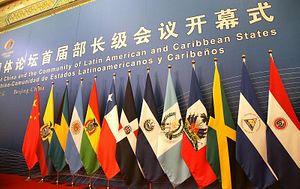During the last 20 years, China has penetrated into Latin America, mostly through a network of relations with friendly nationalist governments that saw Beijing as an alternative to Washington. That fact challenged the image of China’s “ideologically free” foreign policy. At the turn of the new decade, however, the combination of a robust anti-China administration in the United States and the end of leftist-nationalists governments in the region seemed to spell trouble for Chinese interests. Nevertheless, although tempered, China’s diplomatic appeal in the region appears to be outlasting the political fate of its allies.
Friendly Latin American governments received important Chinese trade and investments in transport infrastructure, natural resources, commodities, and low-cost manufactured goods. Lately, China’s tech giants have developed communication infrastructure and began to provide services as well. Some of those infrastructure projects, although not labeled as such, could fit within the broader framework of the Belt and Road. China has been a vital lender to countries like Argentina or Venezuela. Venezuela may be the paradigm of those relations, as Chinese products inundated the market and China surpassed the United States as Venezuela’s primary trade partner and oil purchaser.
In the mentioned friendly countries and others like Lula’s Brazil, China obtained better deals, with a significant role played by embassies and government-to-government relations. In countries with a market-oriented approach, Chinese penetration has been lower.
Chile may have been the exception. Despite being one of the most free-market friendly countries in the region, China has been for years Chile’s most important investor and buyer of copper, lithium, and other minerals. Nevertheless, in Chile China had to adjust to deals driven by market prices. For instance, in 2019, China’s Tianqi had to agree to a secondary position in the control of mining company SQM.
When Donald Trump came to power in the United States, his protectionist rhetoric appeared to provide an important opening to Chinese interests in the region. Nevertheless, the changing political landscape of the area and the growing backlash to Xi Jinping’s China globally prevented any dramatic expansion of Chinese influence in Latin America.
In the late 2010s it was clear that socialist governments in Latin American were in retreat. Given this new reality, Chinese capital needed to adjust its approach to the Latin American market. A meaningful change has been that private investors and entrepreneurs took the lead on investments and trade in the region. State-owned enterprises have taken a secondary role, and private investors have profited from the opportunities given by governments open to foreign investment.
At the same time, China’s relations with unstable governments like Venezuela have cooled down. The China Institute of International Studies’ Blue Book reports about left-wing governments in South America have been increasingly negative, including sharp criticisms of the economic performances of Bolivia and Venezuela. Nevertheless, in the case of Venezuela, although China refused to bail the country out with loans again, Beijing has invested too much to let the Bolivarian government fall to a U.S.-backed candidate.
On the other hand, China’s relations with right-wing leaders haven’t been as bad as expected. Mauricio Macri’s Argentina re-adjusted and extended some of the deals of the previous Cristina Fernandez de Kirchner administration. The return of (moderated) Peronists to power may open new opportunities to China. In Brazil, Jair Bolosonaro came into power with strong anti-China rhetoric and as a close ally of Donald Trump. Nevertheless, Bolsonaro hasn’t followed Washington’s path on his approach to China. He has instead secured China as a crucial commercial partner, being open to using Huawei to develop 5G networks in the country. The Trump administration tariffs on Brazilian goods haven’t helped the U.S. case.
For Beijing, and for any other government, it is usually more desirable to deal with ideologically friendly administrations. The case of Latin America proves, nevertheless, that values are only a part of international relations. The structural changes in the global system provoked by the changing U.S. role and the rise of China go beyond the short-term political context. Nevertheless, the articulation of a non-Western counterhegemonic model indeed appears to be losing its appeal. For instance, the BRICS are not seen as the seed of new world order anymore, with their internal divisions and the loss of Brazilian socialist presidents who long served as voices opposed to the United States.
Despite their vast political distance, one thing that right-wing administrations share with their socialist predecessors is the idea that Latin American countries should be more independent from Washington. And China’s presence in the region allows that. The Chinese market’s vast appetite for natural resources and agricultural products, and Chinese companies’ affordable consumer goods for developing markets, are unmatched by the United States. Beijing, aware of this, has adopted a realist and practical approach to the situation. However, it is still soon to conclude if the Latin American right would be able to maintain their position toward Beijing if Washington’s neo-cold war approach intensifies.
Miquel Vila Moreno is an independent analyst based in Barcelona. He is a political scientist with a Master’s in International Security from the University of Groningen. Follow him on Twitter: @nomos46.

































